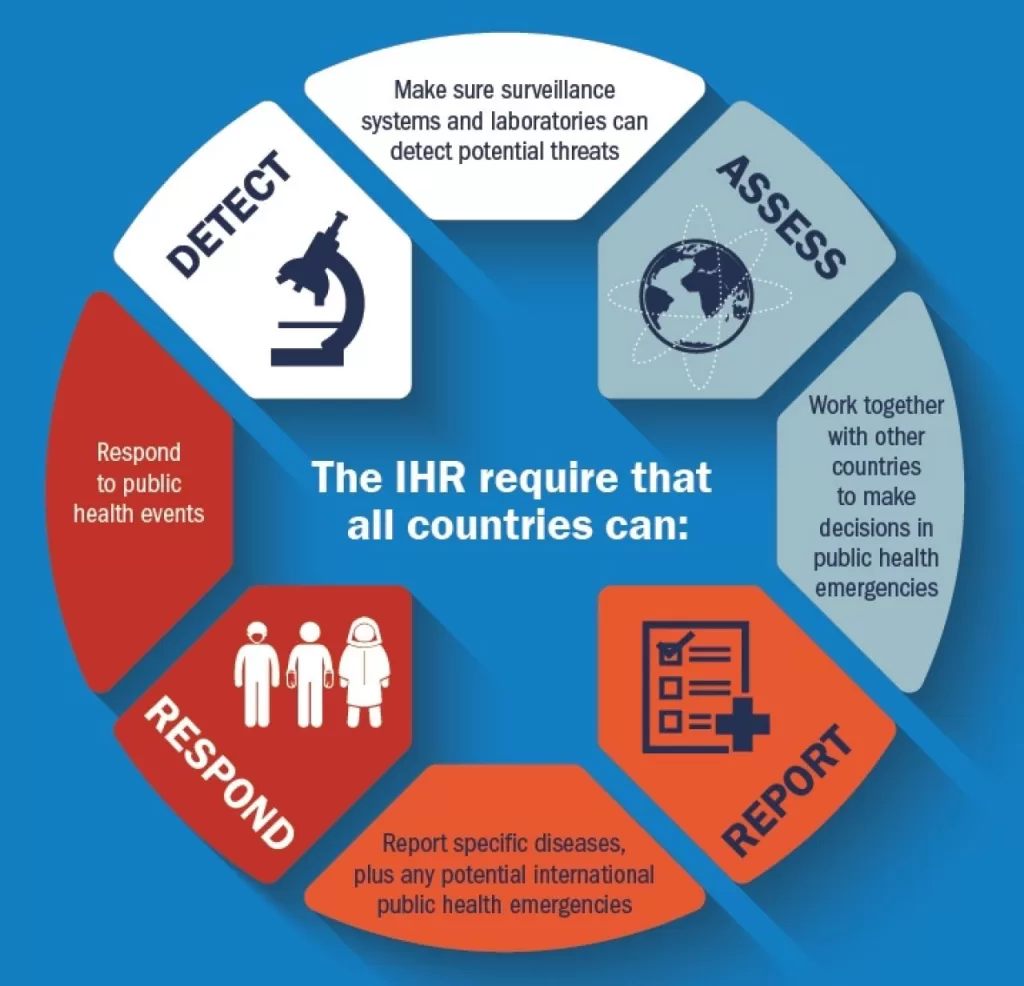The newly announced Global Health Security Strategy marks a significant step in the United States’ commitment to enhancing international health safety measures. Designed in the wake of the COVID-19 response, this strategy outlines a comprehensive plan to prevent and mitigate biological threats over the next five years. It emphasizes pandemic prevention through strengthened public health strategy and international collaboration, ensuring that nations are better prepared for future outbreaks. By drawing on lessons learned from the recent pandemic, the administration aims to mobilize support and resources that enhance global health security capacities. The strategy not only addresses immediate needs but also aims to fortify the global health framework against emerging threats, fostering a safer world for all.
The recent initiative to bolster international health safety can be seen through various lenses, such as pandemic preparedness and response to emerging health risks. This strategic framework prioritizes the establishment of robust defenses against biological hazards by enhancing cooperative efforts across nations. The emphasis on mobilizing political will and financial resources highlights the need for a cohesive global approach to health security. Furthermore, integrating lessons from past health crises allows for the refinement of public health practices, ensuring that future outbreaks are effectively managed. Ultimately, this comprehensive strategy seeks to promote resilience, equity, and a collective response to health emergencies.
Understanding the Importance of the Global Health Security Strategy
The new Global Health Security Strategy is a critical initiative aimed at enhancing the United States’ preparedness to face biological threats and pandemics head-on. With the painful lessons learned from the COVID-19 pandemic, it’s essential that nations adopt comprehensive public health strategies that prioritize rapid detection and response mechanisms. By focusing on the prevention and mitigation of potential outbreaks, this strategy aims to safeguard public health and build resilience within communities.
Moreover, this strategy is not solely about local response; it highlights the need for international cooperation. Encouraging bilateral partnerships between nations can significantly bolster health security capacities globally. By sharing resources, information, and best practices, countries can develop a cohesive front against emerging health threats. Such global solidarity is vital in an interconnected world where a disease outbreak can swiftly transcend borders.
Lessons Learned from COVID-19 to Enhance Pandemic Prevention
The experiences garnered from the COVID-19 response are instrumental in shaping future pandemic prevention efforts. The Lessons learned emphasize the necessity for robust health security measures that can be activated in the face of biological threats. This includes prioritizing epidemiological surveillance systems and enhancing testing and vaccination capabilities. Effective communication and early response strategies are equally critical to mitigate panic and misinformation during future outbreaks.
Additionally, the strategy outlines the importance of equity and social inclusion in health initiatives. Ensuring that all communities have access to pandemic prevention resources is vital for a comprehensive response that protects everyone. By incorporating lessons from past crises into the framework of the Global Health Security Strategy, the Biden administration aims to create a more resilient public health infrastructure that can adapt to evolving threats.
Mobilizing Political Commitment for Health Security
The success of the Global Health Security Strategy hinges on mobilizing political commitment at all levels of government and within the private sector. This is crucial because financial resources and leadership will dictate the effectiveness of health security measures put forth. The administration’s proactive stance in delineating specific targets for health capacity and resource mobilization showcases a commitment to addressing not only the symptoms but the root causes of public health crises.
Furthermore, political leaders must not only provide funding but also advocate for health security as a national priority. It is imperative that communities understand the investment in public health is a safeguard against potential economic losses and social instability that come with pandemics and health crises. By galvanizing collective action and commitment, the U.S. can work toward achieving a more secure global health environment.
Strengthening Global Partnerships for Enhanced Health Security
Enhancing global health security capacities necessitates building robust international partnerships. Through collaborative efforts, nations can share expertise and resources crucial for effective biological threat prevention. Such partnerships can facilitate joint training exercises, technology transfers, and coordinated responses to outbreaks, benefitting all countries involved. The commitment to strengthening bilateral relationships is a cornerstone of the new strategy, emphasizing mutual support in times of health crises.
Moreover, engaging with international organizations and non-governmental entities can broaden the scope of health security initiatives. By aligning with global health agencies, the U.S. can play a pivotal role in shaping global responses and health policy frameworks that prioritize pandemic preparedness. The strategy acknowledges that biological threats do not discriminate by borders and require a united global effort to mitigate their impact.
Integrating Equity in Public Health Strategies
One of the pivotal themes of the Global Health Security Strategy is the integration of equity and social inclusion in public health strategies. Acknowledging that marginalized and underserved communities often bear the brunt of health crises, the strategy proposes to elevate these voices in the planning and implementation phases of health initiatives. By focusing on equitable access to health resources, the strategy aims to prevent disparities in health outcomes during future pandemics.
Moreover, the commitment to equity ensures that resources for pandemic prevention are distributed justly across different populations. This approach is essential for fostering resilience as it protects vulnerable communities that are at higher risk during outbreaks. A comprehensive strategy that includes health equity will not only save lives but will also ensure a more stable and healthy society in the long run.
The Role of Financial Investment in Health Security
Financial investment is central to the realization of the aims outlined in the Global Health Security Strategy. It is imperative that robust funding mechanisms are developed and sustained to ensure that health security measures are effectively implemented. Investment in public health infrastructure, research and development, and healthcare workforce training are fundamental components that need considerable financial backing to thrive.
Additionally, leveraging private sector investments can also accelerate the advancements necessary for health security. Collaborations with businesses can lead to innovative solutions for pandemic preparedness, such as rapid diagnostics and vaccine development. By creating a culture of investment in health security, the U.S. can build a stronger and more resilient healthcare system capable of withstanding future biological threats.
Developing Comprehensive Surveillance Systems
A key element in combating biological threats is the development of comprehensive surveillance systems. The new strategy emphasizes enhancing capabilities for early detection of pathogens and a comprehensive understanding of disease epidemiology. Integrating technology and data analytics can improve the speed and accuracy of detecting outbreaks, allowing for timely interventions that can minimize spread and impact.
Moreover, these surveillance systems should be interconnected globally to provide real-time information sharing across borders. Establishing a network that allows for rapid response and collaboration during health emergencies will create a robust barrier against pandemics. The strategic focus on advanced surveillance reflects the urgent need for proactive public health measures that can respond dynamically to biological threats.
Fostering Research and Innovation in Health Security
Investing in research and innovation is crucial for advancing the goals outlined in the Global Health Security Strategy. The strategy calls for fostering a culture that prioritizes scientific exploration into potential biological threats, including emerging infectious diseases. By supporting research on vaccines, treatments, and public health interventions, the U.S. aims to enhance its ability to prevent and respond to future health crises.
Furthermore, collaboration between governmental bodies, academic institutions, and the private sector is vital for driving innovation. By creating an ecosystem that encourages the sharing of knowledge and resources, the strategy supports the continuous improvement of pandemic preparedness frameworks. It emphasizes that a strong foundation in research and innovation is essential for not only responding to current biological threats but also anticipating future challenges.
The Impact of Global Health Security on Future Pandemics
The implementation of the Global Health Security Strategy is expected to have far-reaching implications for future pandemic management. By establishing a proactive stance against biological threats, the U.S. is setting a precedent for how nations respond to emerging health crises. Effective strategies could significantly reduce the occurrence and severity of pandemics, translating to better health outcomes and economic stability.
As nations work together under this strategy, there is hope for increased global readiness in the face of biological challenges. The collaborative efforts emphasized in the strategy are designed to create a resilient health system capable of responding to and mitigating the impacts of future pandemics. The focus on continuous improvement and adaptation in health security measures ensures that lessons learned today will enhance preparedness for tomorrow’s threats.
Frequently Asked Questions
What is the Global Health Security Strategy announced by the Biden administration?
The Global Health Security Strategy, announced by the Biden administration on April 16, 2024, outlines a plan for the United States to enhance its capacity to prevent, detect, and respond to biological threats over the next five years. This strategy builds on the experiences gained from the COVID-19 response and seeks to reinforce public health measures and international partnerships.
How does the Global Health Security Strategy address pandemic prevention?
The Global Health Security Strategy incorporates pandemic prevention as a core element, drawing on lessons learned from the COVID-19 pandemic. It aims to strengthen global health security by promoting bilateral partnerships, enhancing local health capacities, and ensuring the nation is prepared for future outbreaks and biological threats.
What are the main goals of the new Global Health Security Strategy?
The Global Health Security Strategy focuses on three primary goals: 1) Strengthening global health security capacities through partnerships, 2) Mobilizing political commitment and resources to enhance public health strategies, and 3) Leveraging synergies between health security measures and complementary health programs to promote overall better health outcomes.
How does the Global Health Security Strategy plan to improve health security in developing countries?
The Global Health Security Strategy aims to improve health security in developing countries by achieving capacity goals in 50 additional nations by 2024. It emphasizes the importance of country ownership and resource mobilization to ensure sustainable health security measures and equitable access to health resources.
What lessons from the COVID-19 response are included in the Global Health Security Strategy?
The Global Health Security Strategy integrates important lessons from the COVID-19 response, emphasizing the need for robust emergency preparedness, effective communication, and comprehensive public health strategies that include equitable access to healthcare, targeted interventions, and international collaboration to combat biological threats.
How will the Global Health Security Strategy promote equity in health security measures?
The Global Health Security Strategy incorporates equity and social inclusion factors to protect individuals from infectious disease threats. This approach aims to ensure that vulnerable populations are prioritized and included in public health initiatives and resources, addressing disparities exacerbated by the COVID-19 pandemic.
What is the significance of the Global Health Security Strategy in relation to biological threats?
The Global Health Security Strategy is significant as it establishes a comprehensive approach to enhance the United States’ preparedness against biological threats, including pandemics. It highlights the need for robust public health infrastructure, international cooperation, and effective response frameworks to mitigate risks and safeguard global health.
How will the Global Health Security Strategy affect future public health strategies?
The Global Health Security Strategy will inform future public health strategies by providing a framework for addressing biological threats and pandemics more effectively. It encourages continuous improvement in health security measures and fosters collaboration among nations to ensure better preparedness for future health crises.
| Key Points | Details |
|---|---|
| Announcement of New Strategy | Biden administration’s 5-year plan to tackle biological threats. |
| COVID Impact Acknowledgment | Emphasizes lessons learned from the COVID pandemic. |
| Overarching Goals | 1. Strengthen global health security capacities 2. Mobilize political commitment and financing 3. Leverage connections between health security and other programs |
| 2024 Targets | Achieve health capacity in 50 additional countries, focus on equity and inclusion. |
Summary
The newly released Global Health Security Strategy highlights the United States’ commitment to enhancing its response capabilities for future health crises. By focusing on the lessons learned from the COVID pandemic, this strategy aims to strengthen global health security, mobilize resources, and ensure that every individual is protected against biological threats. The goals outlined in this strategy reflect a comprehensive approach to not only respond to threats but also to prevent them in collaboration with other nations.
The content provided on this blog (e.g., symptom descriptions, health tips, or general advice) is for informational purposes only and is not a substitute for professional medical advice, diagnosis, or treatment. Always seek the guidance of your physician or other qualified healthcare provider with any questions you may have regarding a medical condition. Never disregard professional medical advice or delay seeking it because of something you have read on this website. If you believe you may have a medical emergency, call your doctor or emergency services immediately. Reliance on any information provided by this blog is solely at your own risk.








